Houfflaize Panther Tank Ausf. G
This Surviving German Panzer V Panther Tank took part in the 1944 WW2 Battle of the Bulge in the Belgium Ardennes. It has been preserved and can be visited in the village of Houfflaize, Belgium. You will find it at the junction of the N30 Rue de Bastogne with the Rue Saint-Roch.
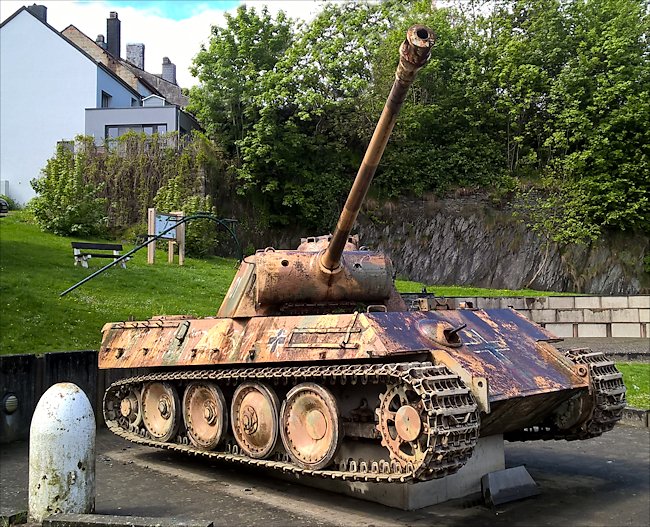
German PzKpfW V Ausf. G Panther Tank in the village of Houfflaize
The Houfflaize Panther Ausf G tank, turret number 111, originally came from Pz.Regt I./24 and was with Pz.Regt I./16 when it was knocked out. According to statements by veterans of the 116th PD and residents the tank fell over due to detonation pressure by dropped bombs into the Ourthe river and landed on the turret. The crew died because of the impact or drowned. This Panther was recovered out of the river Ourthe by French engineers on 20th September 1947, the remains of the crew killed in the attack were discovered when the Panther was pulled from the river. It has been repainted with a three tone camouflage scheme and now displays the 'Windhund' insignia of the 116 Panzer Division.
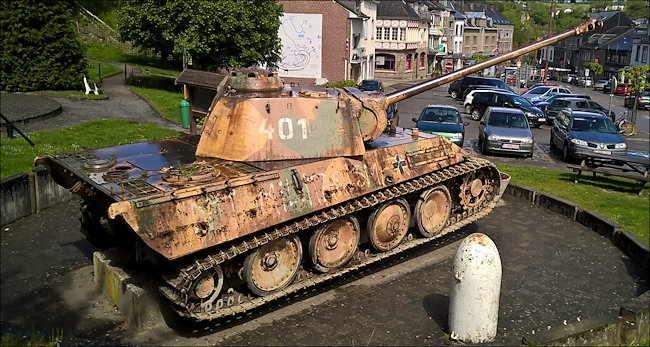
German Panzer V Panther Tank in the village of Houfflaize
During the early part of the battle of the Bulge on 18th December 1944, the Reconnaissance Battalion, 116th Panzer Division had overcome some American resistance south of the village of Houfflaize, near the Luxembourg border. Problems over the supply of fuel and traffic jams on the roads around Dasburg was causing problems for the main advance. By the evening, the Division was ready to thrust westwards towards Houfflaize. The town was taken without a fight.
Houfflaize stayed in German control for one month. The first and third American armies were trying to encircle the retreating Germans in a pincer movement. The German offensive has started on 16th December 1944. They linked up at Houfflaize on 16th January 1945, but the bulk of the threatened German units managed to escape the trap.
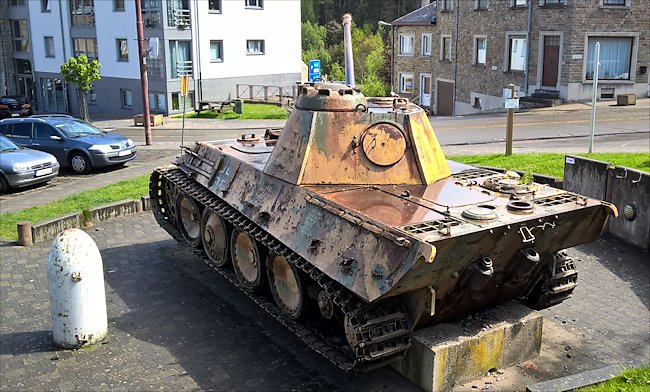
Rear view of the Houfflaize Panther tank
What do Panther Tank crews fear most?
On 25th December 1944 the British 29th Armoured Brigade and the American 82nd Armoured Reconnaissance Battalion were engaged by German Panzers including three Panther tanks around the farm called Ferme de Mahenne east of the Belgium Ardennes village of Foy-Notre-Dame. One of the locals, Noel Bell, witnessed what happened.
"So we found a convenient little plateau on the southern outskirts of Sorinnes where we settled down to await developments. At first all seemed peaceful on the objective and then figures of men in quite large numbers began running about. Some said they were German, some said they were Americans and the confusion was increased when two large tanks could be seen silhouetted against the skyline."
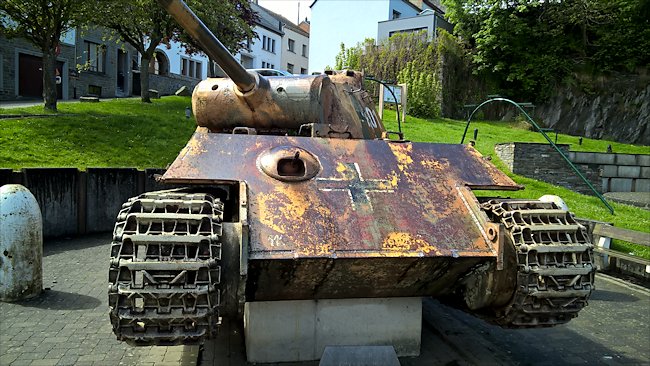
Panther tanks were successful because of their wide tracks and good sloping armour.
"They looked very much like Panther tanks but then someone said that they were Americans tank destroyers. The Germans had been using a great deal of captured American equipment and these controversial steel monsters facing us could be one of three things; Panther tanks, US tank destroyers, US tank destroyers manned by Germans."
"However we did not have long to wait before we heard a distant throb of aircraft and with engines screeching, a squadron of American Lightning fighter bombers roared over us. They circled low over the opposing ridge."
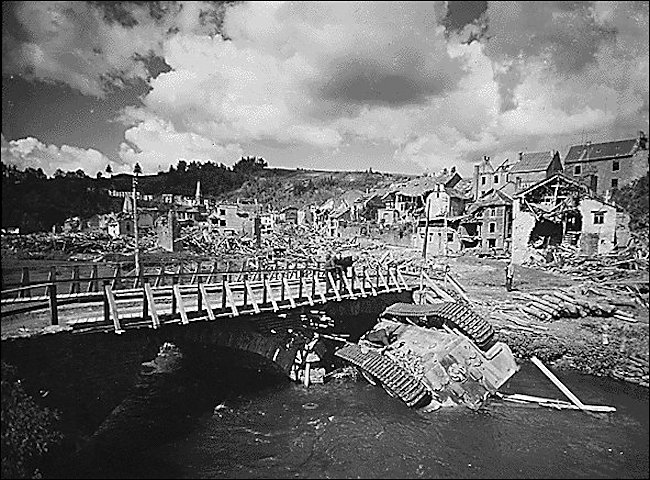
This Panther Tank was blown into the river by a bomb. The village of Houfflaize was practically destroyed in 1944.
"It evidently did not take the pilots long to make up their minds. The German force was subjected to merciless and incessant attack from the Lightnings, which soon began to dive to rooftop height with machine guns blazing and dropping bombs at the same time. The explosions rocked our position some two kilometers away. All the farm buildings were either destroyed or blazing fiercely. The three Panthers were knocked out."
The front armour protection of the Panther tank may have been nearly impenetrable by allied anti-tank armour piercing shells, but the Panther tank crews really feared being caught out in the open and exposed to allied air attack.
The Panther Tank Driver's Story
On the 21st December 1944 during the Battle of the Bulge near La Gleise Untersturmfuhrer Hennecke recalled, "My Panther tank was hit. I climbed into the company commander’s panzer and ordered my driver, Rottenführer Bahnes, to take our Panther to the maintenance shop. Today, on 21st December, we were encircled at La Gleize and Stavelot was again in the hands of the Americans. We heard the sounds of armoured vehicles coming from Trois Ponts."
"We drove our panzers into position in order to give the attacking Americans a reception. Out of the morning fog appeared the first panzer. Thank God I recognized in time that it was a Panther. When number 111, my vehicle, was noticed, the ‘open fire’ order was rescinded. The turret hatch of the panzer opened and a shape left the vehicle with raised arms. A second followed – my driver, Rottenführer Bahnes!"
"He described how, immediately after the end of the fighting in Stavelot he had begun to repair the panzer. He took parts from another shot-up panzer. When the Americans pushed back into Stavelot he did not leave, rather he kept still and quietly went on with his repairs."
"The Americans did not concern themselves with a wreck. During the second night someone knocked on the vehicle. A straggler, a Wehrmacht Oberleutnant, who had determined that the panzer was occupied and wanted to be let in. After the repairs, the wagon could run in 3rd and 4th gears, so he resolved to follow us with it. He taught the Oberleutnant how to operate the turret."
"Then they were off. With a fiercely turning turret the Panther raced through Stavelot. The Americans were so disconcerted that they were unable to bring any anti-tank gun into position in time to shoot at the panzer. Bahnes was promoted to Unterscharführer and awarded the Iron Cross for this 'stroke of genius'. Unfortunately, he was killed in the last days of the war."
Where can I find other preserved Panther Tanks?
- Panther Ausf. A - Wheatcroft Collection, England
- Panther Ausf. A - Befehlspanzer Munster Germany (running condition)
- Panther Ausf. A - (n° 224) Auto + Technik Museum, Sinsheim, Germany
- Panther Ausf. A - (n° 243) Auto + Technik Museum, Sinsheim, Germany
- Panther Ausf. A - (n° 413) Private Collection, Germany
- Panther Ausf. A - (n° 256) Saumur Tank Museum France
- Panther Ausf. A - (n° 211) Saumur Tank Museum France (running condition)
- Panther Ausf. A - Omaha Overlord Museum, Colleville-sur-Mer, France
- Panther Ausf. A - 501/503e RCC Mourmelon-le-Grand France
- Panther Ausf. A - (n° 201) Royal Jordanian Tank Museum, Jordan
- Panther Ausf. A - Australian Armour and Artillery Museum, Cairns, Queensland.
- Panther Ausf. A - National Armor and Cavalry Museum, Fort Benning, GA,USA
- Panther Ausf. A - U.S. Army Ordnance Museum, Fort Lee, VA, USA
- Panther Ausf. A - The Collings Foundation, Stow, MA, USA (running condition)
- Panther Ausf. A - Canadian War Museum (CWM) in Ottawa Canada
- Panther Ausf. A or D Panzermuseum, Thun, Switzerland
- Panther Ausf. D - Breda Netherlands
- Panther Ausf. G - Bovington Tank Museum England (British Built)
- Panther Ausf. G - Wehrtechnische Dienststelle, Trier, Germany (British Built)
- Panther Ausf. G - Privately owned now confiscated by police, Germany (British Built)
- Panther Ausf. G - National War and Resistance Museum, Overloon Netherlands
- Panther Ausf. G - Houffalize Belgium
- Panther Ausf. G - Grandmenil Belgium – engine, gearbox and transmission are present
- Panther Ausf. G - Celles Belgium
- Panther Ausf. G - (n° 332) Saumur Tank Museum France
- Panther Ausf. G - Kubinka Tank Museum Russia (running condition)
- Panther Ausf. G - U.S. Army Ordnance Museum, Fort Lee, VA, USA
- Panther Ausf. G - 2x National Armor and Cavalry Museum, Fort Benning, GA, USA
- Source - Pierre-Oliver Buan - http://the.shadock.free.fr/Surviving_Panzers.html
Battle of the Bulge books

